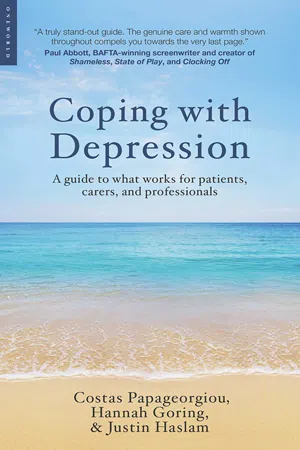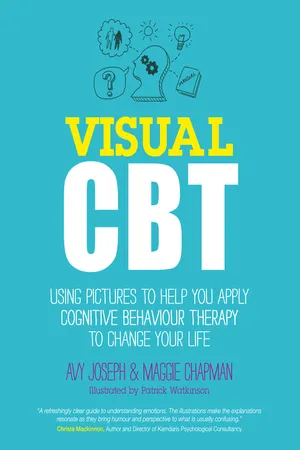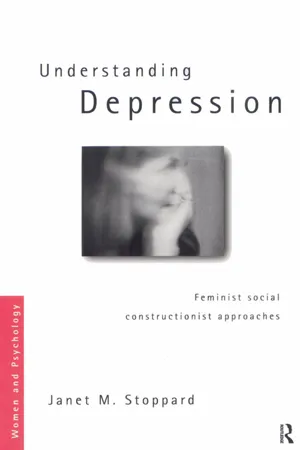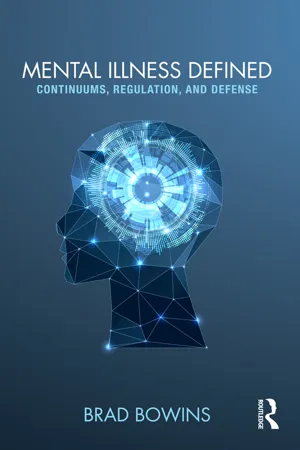Depression
Depression is a mental health disorder characterized by persistent feelings of sadness, hopelessness, and a loss of interest in activities. It can impact a person's thoughts, emotions, and physical well-being, often leading to difficulties in daily functioning. Symptoms may vary in severity and duration, and treatment typically involves a combination of therapy, medication, and lifestyle changes.
8 Key excerpts on "Depression"
- eBook - ePub
- Constance Hammen, Ed Watkins(Authors)
- 2018(Publication Date)
- Routledge(Publisher)
...It is enormously impairing – and even deadly – and its effects on both the afflicted person and his or her family can be profoundly negative. Yet, we also have a number of effective treatments for Depression and science is gaining considerable insight into the processes underpinning Depression. Phenomenology of depressive experiences The term Depression is used in everyday language to describe a range of experiences from a slightly noticeable and temporary mood decrease to a profoundly impaired and even life-threatening disorder. When used to describe a mood, the term conveys a temporary state of sadness and loss of energy or motivation that may last a few moments, hours, or even a few days. As such, it is usually a normal reaction to an upsetting event, or even an exaggerated description of a typical event (‘this weather is depressing’). A young man might feel sad for a few days following a romantic disappointment, or a woman might be discouraged for a few days upon being passed over for a job. Such experiences are not the topic of this book. Rather, the term ‘Depression’ as used here refers to a constellation of experiences including not only mood, but also physical, mental and behavioural experiences that define more prolonged, impairing and severe conditions that may be clinically diagnosable as a syndrome of Depression. The description at the beginning of the chapter may differ from the personal experiences of other depressed people, but all share features of the syndromes of Depression. Each sufferer has features from the four different domains that define depressive disorders. The four general domains are affect, cognition, behaviour and physical functioning. Affective symptoms Depression is one of several disorders generically called affective disorders, referring to the manifestations of abnormal affect or mood, as a defining feature. Thus, depressed mood, sadness, feeling low, down in the dumps or empty are typical...
- eBook - ePub
Coping with Depression
A Guide to What Works for Patients, Carers, and Professionals
- Costas Papageorgiou, Hannah Goring, Justin Haslam(Authors)
- 2011(Publication Date)
- Oneworld Publications(Publisher)
...In terms of changes in behaviour, people may be slowed down so that they talk or move noticeably slower than normal, or they may instead appear agitated or restless and unable to relax. They may feel they have no motivation to engage in even the most straightforward activities, and they may withdraw from other people. Changes in thinking include difficulties in concentration, decision-making and memory. In addition, it is common for people with Depression to have negative thoughts about themselves, the world and the future. They tend to be self-critical and commonly have feelings of guilt, worthlessness or hopelessness about the future. People with Depression can also become preoccupied with thoughts of death or suicide. Physical symptoms include reduced energy levels, disturbed sleep and changes in appetite. The above description reveals that Depression can affect many areas of life. It is important to remember that Depression is not a sign of character weakness or some kind of moral weakness. Nor is it something that people can simply ‘snap out of’. How Depression is diagnosed To diagnose Depression a doctor, psychiatrist or other mental health professional will use agreed criteria provided by systems for classifying and diagnosing mental health problems. 1, 2 These systems are not without their problems and limitations, but we describe them here because they are frequently used to diagnose Depression, and they provide useful lists of symptoms. The American Psychiatric Association has published one of these systems, which is called the Diagnostic and Statistical Manual of Mental Disorders. (This is currently on a revised version of its fourth edition and is known as the DSM-IV-TR for short. The other system currently in use is the International Classification of Mental and Behavioural Disorders – Version 10 (ICD-10) published by the World Health Organization)...
- Annamaria Di Fabio, Donald H. Saklofske, Con Stough(Authors)
- 2020(Publication Date)
- Wiley(Publisher)
...Depression Katerina Rnic and David J. A. Dozois University of Western Ontario Depression is a common and debilitating disorder that is highly recurrent. It is associated with significant economic, social and personal cost due to the number of sick days, medical expenses, and lowered quality of life it engenders. Depression is the leading cause of disability worldwide (WHO, 2012), and accounts for $60 billion in lost productivity in North America each year. Individual suffering is considerable; Depression predicts divorce, poor interpersonal and occupational functioning, and low socio‐economic status. Approximately 4–7% of depressed individuals kill themselves, and Depression is associated with greater risk of obesity, metabolic syndrome, diabetes, stroke, and all‐cause mortality (see Gotlib & Hammen, 2014). An episode of major depressive disorder (MDD) is defined by the Diagnostic and Statistical Manual of Mental Disorders (DSM ‐5; APA, 2013) as a period of at least two weeks of low mood (or irritable mood in children) and/or anhedonia (i.e. loss of interest or pleasure in previously reinforcing activities). Additional symptoms include changes in appetite or weight (increase or decrease), changes in sleep (insomnia or hypersomnia), psychomotor agitation or retardation, low energy or fatigue, poor concentration or difficulty making decisions, excessive or inappropriate guilt or feelings of worthlessness, and thoughts of death or suicide. Diagnostically, an individual must experience five out of nine symptoms. It is important to note that individuals from non‐Western cultures are more likely to endorse somatic symptoms, such as disturbances in sleep, energy, or appetite, than affective symptoms, such as depressed mood. As well, diagnosticians must use their clinical judgment to determine whether depressive symptoms constitute an episode of MDD, or are a normative reaction to a major stressful life event involving loss (e.g...
- eBook - ePub
Visual CBT
Using Pictures to Help You Apply Cognitive Behaviour Therapy to Change Your Life
- Avy Joseph, Maggie Chapman, Patrick Watkinson(Authors)
- 2012(Publication Date)
- Capstone(Publisher)
...CHAPTER 2 Depression and Sadness Depression is second to anxiety as the most commonly experienced emotional disturbance. Depression can affect us all at some point or another; women have over twice the incidence of Depression than men. This is thought to be due to hormonal influences throughout a woman’s life. Here we will explore psychologically based Depression as opposed to chemically or organically based Depression. Types of Depression There are several different types of Depression. They are usually distinguished by their dominant features, duration and severity of symptoms. Most of these kinds of Depression are defined by the Diagnostic and Statistical Manual of Mental Disorders (DSM), an American Psychiatric Association publication. The following three different kinds of Depression are distinct depressive disorders described in the DSM. Sufferers experience significant distress and /or impairment of functioning, e.g. work, school, relationships and so on. Major Depressive Disorder (also known as Major Depression, Clinical Depression) – A major depressive episode occurs with symptoms that last for most of the day, nearly every day for at least two weeks. Dysthymic Disorder – This is less severe than Major Depression but lasts at least two years. Bipolar Affective Disorder – also known as Manic Depression or Bipolar Disorder. This is a condition which causes mood swings. Your mood varies from excitement to Depression and despair...
- eBook - ePub
Understanding Depression
Feminist Social Constructionist Approaches
- Janet Stoppard(Author)
- 2014(Publication Date)
- Routledge(Publisher)
...2 WHAT IS Depression? Definitional debates DOI: 10.4324/9781315787961-3 In the previous chapter, I discussed different meanings of the term Depression and drew a distinction between the way mental health professionals and researchers use this word and how it is used by ordinary people. When used by professionals and researchers, the word Depression normally means depressive disorder or depressive symptoms (these terms were defined in Chapter 1). In this chapter, I discuss these two ways of conceptualizing Depression in more detail, considering how they are employed in practise and also examining the assumptions on which they are based. An issue of particular interest to researchers and professionals (especially those in North America) is the need to distinguish between depressive disorder and depressive symptoms. Although these two ways of conceptualizing Depression can be differentiated, they also have features in common which distinguish them from a third way of understanding Depression, depressive experiences. When Depression is understood in this way, the perspective shifts from that of researchers and professionals to that of women who are depressed, with a focus on subjective experiences. In the theoretical approaches to Explaining Depression in Women discussed in Part II, Depression has been conceptualized as either depressive disorder or depressive symptoms. If considered at all, women’s depressive experiences serve mainly as a resource used by researchers and professionals for diagnosing depressive disorder or for establishing the presence of depressive symptoms. Thus women’s depressive experiences are not of direct interest in most positivist approaches to research and professional practise. From a feminist perspective, in contrast, women’s reports of their depressive experiences are viewed as having meaning in their own right...
- eBook - ePub
Mental Illness Defined
Continuums, Regulation, and Defense
- Brad Bowins(Author)
- 2016(Publication Date)
- Routledge(Publisher)
...Chapter 2 Depression Throughout recorded history there is evidence of Depression, and it comprises one of the most common conditions mental health professionals treat, supporting the position that it is a naturally occurring entity, at least for humans. However, how it is structured is debatable. Throughout the history of psychiatry there has been a tendency to view Depression as consisting of discrete types. Two types have traditionally been identified: Endogenous, vital, or melancholic, and reactive, neurotic, or dysthymic (Healy, 2013; Kiloh et al, 1972; Parker et al, 1988; Paykel, 2008). Melancholia was identified at the time of Hippocrates and persisted as a diagnosis through Galenic and medieval times (Paykel, 2008). In 1621, Richard Burton wrote The Anatomy of Melancholia (in Paykel, 2008). Carl Lange, in 1880, identified a disorder with neurovegetative features that became known as endogenous or vital Depression (in Healy, 2013). Psychoanalysts led by Freud were instrumental in advancing the notion of reactive Depression, in which the actual or symbolic loss of a love object gives rise to Depression (in Shorter, 1997). According to Alfred Meyer all psychiatric illness consists of a psychobiological reaction to stress (in Paykel, 2008). Discrete endogenous and reactive forms of Depression are consistent with the medical disease model, whereby distinct con-ditions demonstrating etiological, symptom, course, and treatment differences occur (Paykel, 2008). The alternative—the unitary perspective maintaining that Depression is a single entity with various manifestations—aligns with the overlapping features of Depression (Parker et al, 1991; Parker, 2013). Diagnostic systems such as the Diagnostic and Statistical Manual (DSM) and the International Classification of Diseases (ICD) have proposed discrete forms of Depression—understandably, given that the disease model is the basis for these classification systems...
- eBook - ePub
ADHDAttention Deficit Hyperactivity Disorder
A Tutorial Study Guide
- Nicoladie Tam(Author)
- 2015(Publication Date)
- Nicoladie Tam, Ph.D.(Publisher)
...It is the unpleasant feeling and/or the inability to experience any emotions or pleasure. The feeling of sadness is often associated with the sense of loss of things that are valuable to the person. The sense of despair in Depression is the emotional state in Depression that nothing can be done to alter the outcome that the person does not desire. What are the symptoms of Depression? The symptoms are: daily occurrence of depressed mood diminished interest in almost all activities diminished experience of pleasure in activities significant weight loss when not dieting or weight gain insomnia or hypersomnia psychomotor agitation or retardation fatigue or loss of energy feeling of worthlessness or inappropriate guilt diminished ability to think or concentrate, or indecisiveness recurrent thoughts of death, recurrent suicidal ideation with or without a specific plan The above symptoms are often occurring most part of the day, every day or nearly every day in depressed patients. The diminished interest is characteristics of the Depression in the reduced motivation to do things. The diminished ability to experience pleasurable activities is also another characteristic of Depression for its inability to derive pleasure from normally pleasurable activities, such as engaging in hobbies. Different depressed person may respond differently with different coping skills. For instance, some cope by eating while others cope by not eating. Some cope by sleeping so much that they cannot get themselves out of bed, while others cope by worrying so much that they cannot fall asleep reminiscing the dreadful worries. Some cope by responding with agitation and restlessness, while others cope by responding with little motivation to do anything. The lack of energy to do anything is very common in depressed state...
- eBook - ePub
Entering the Behavioral Health Field
A Guide for New Clinicians
- Diane Suffridge(Author)
- 2016(Publication Date)
- Routledge(Publisher)
...Psychotic symptoms include delusions, hallucinations, and disorganized speech or behavior. Clients with schizophrenia also may show a decrease in emotional expression and self-initiated action, and such behaviors are called negative symptoms. This category is used when psychotic symptoms are prominent or when the client is taking medication to manage psychotic symptoms which are reported by the client or others who have observed the client closely. Bipolar and related disorders. These disorders are characterized by episodes of elevated mood, reflected in feelings of expansiveness and/or by irritability along with a heightened level of energy. There are often sudden changes in the tone of responses to others as well as the sense of self, ranging from agitation to elation. The client may have depressive episodes in addition to manic or hypomanic episodes. Depressive disorders. Clients with these disorders have a sad, hopeless, or irritable mood, sometimes accompanied by changes in sleep patterns and appetite, feelings of guilt and worthlessness, and a decreased interest or pleasure in most activities. Irritable mood as an indicator of a depressive disorder is more common in children and adolescents than in adults. Anxiety disorders. The client’s clinical presentation is dominated by excessive fear and anxiety, leading to tension and/or avoidance of things or situations that are feared or unpleasant. Cognitive distortions or preoccupations are often associated with the states of anxiety. Obsessive-compulsive and related disorders. These disorders are characterized by intrusive thoughts and/or repetitive behaviors that are excessive and persistent. The preoccupation with these thoughts and behaviors can be time-consuming and/or interfere with aspects of the client’s life. Trauma- and stressor-related disorders. The client’s symptoms develop after the occurrence of a traumatic or stressful event...







